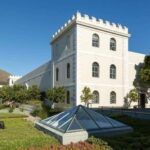Breakwater Gaol
The Breakwater Prison was constructed in 1860 to house British convicts working on the breakwater, which eventually allowed the harbour to be built. A quarry utilised the hard rock just below the gaol in the area where the current aquarium stands. The rock was transported by man-powered rail wagons up the hill and down a tunnel. Having convicts on-site offered advantages. While the old Roeland Street prison had just been completed, it was abandoned while labour was needed at the docks. Many of the prisoners were guilty of petty crimes such as escapees from the service of men who had been press-ganged back in England. This crime was punishable by hard labour..
The building today houses the Breakwater Lodge and the University of Cape Town Graduate School of Business. It is a national monument. The building was called the Industrial Breakwater Prison. The design consists of four castellated turrets and an enclosed courtyard and was based on the Millbank and Pentonville prisons in England. The Industrial Breakwater Prison was a prison for just 10 years. Then it became an institute for juvenile offenders From 1926 until 1989 it was a hostel for black dock workers.
The old Breakwater Gaol on Cape Town shore was a prison long before Robben Island was used as a prison. The two death cells at the end of the row of isolation cells are across the way from the Cape Town traffic department at Gallows Hill.
The prison punishment block also incorporated a treadmill as a form of engine to be powered by humans. It resembled a water wheel. These machines can be worked either by human treading paddles set into its circumference or by a human or animal standing inside them. These devices are no longer used for power or punishment,
The wall of the original prison has graffiti carved into the hard rock by inmates. After a work strike in 1885, when the black and white convicts held meetings in the yard together, prison authorities felt that interracial contact caused trouble and prisoners were segregated. It was the first site to racially segregate black and white convicts. Before this segregation, the sleeping arrangements involved a white convict sleeping between two black convicts. The rationale was that, with the language and cultural barrier, less plotting and dissent would take place.
The Breakwater Prison had a reputation as one of the most feared prisons in the world. According to old stories, there was at least one representative of each nationality of the known world incarcerated here.
Portswood Road, V & A Waterfront,


